Ethical Behavior & Nursing Leadership: A Case Study Analysis
VerifiedAdded on 2023/06/14
|11
|3469
|61
Essay
AI Summary
This essay explores the critical area of ethical behavior in nursing leadership, emphasizing the importance of adhering to nursing standards and scopes of practice. It reflects on the author's proficiency in this area and discusses the challenges of maintaining ethical consistency as a leader. The essay highlights the role of nurse leaders in cultivating ethics and professionalism among the nursing workforce, referencing the health belief model as a theoretical underpinning for ethical decision-making. It details an action implemented to improve skills in this area, involving a group case study analysis of unethical conduct cases from regulatory bodies like AHPRA. The reflection on the experience reveals the importance of creating a serene learning environment and fostering collaboration. The author intends to further promote ethical practice through a blog and continuous knowledge advancements, ultimately aiming to enhance the reputation of the facility and the nursing profession.
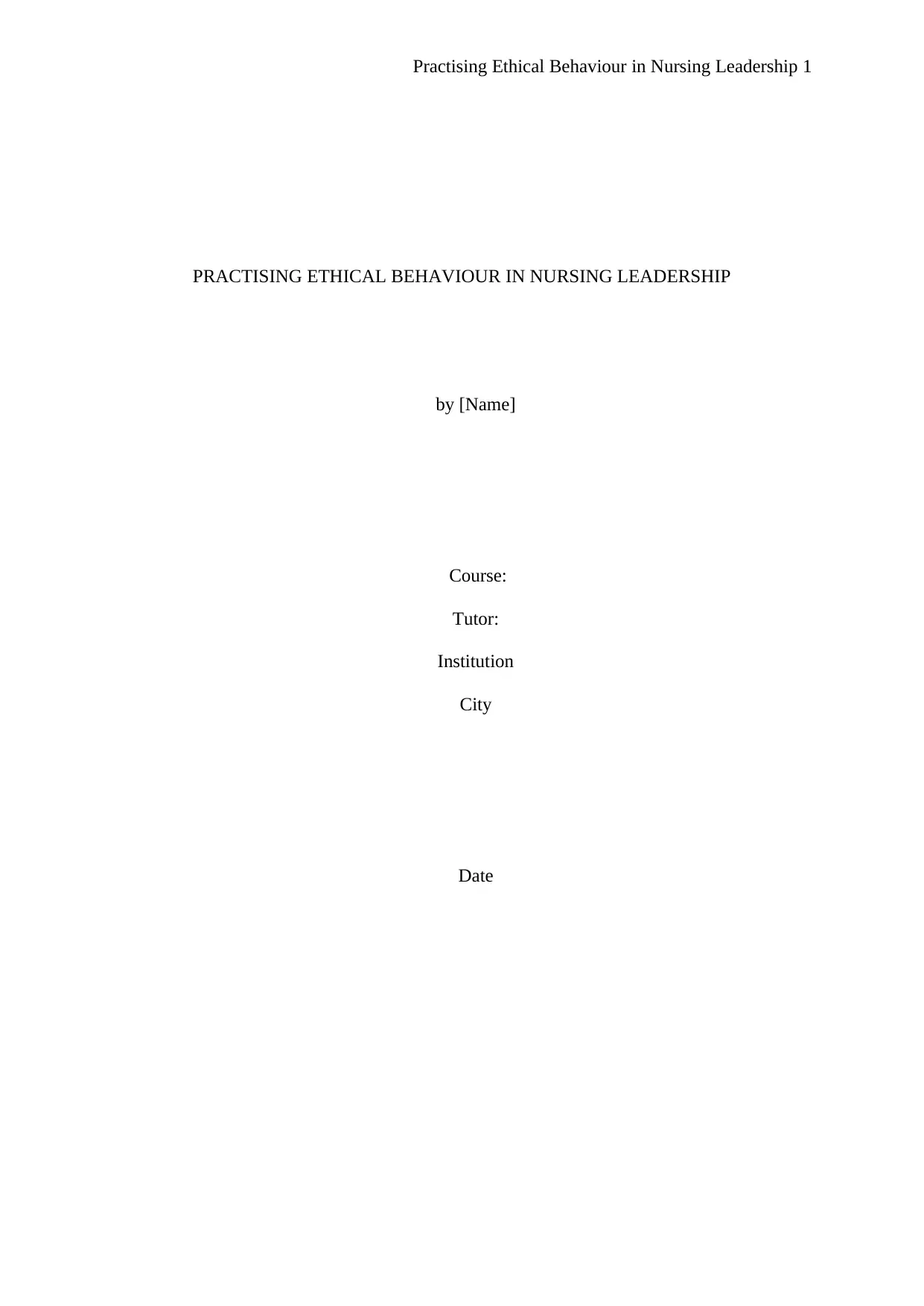
Practising Ethical Behaviour in Nursing Leadership 1
PRACTISING ETHICAL BEHAVIOUR IN NURSING LEADERSHIP
by [Name]
Course:
Tutor:
Institution
City
Date
PRACTISING ETHICAL BEHAVIOUR IN NURSING LEADERSHIP
by [Name]
Course:
Tutor:
Institution
City
Date
Paraphrase This Document
Need a fresh take? Get an instant paraphrase of this document with our AI Paraphraser
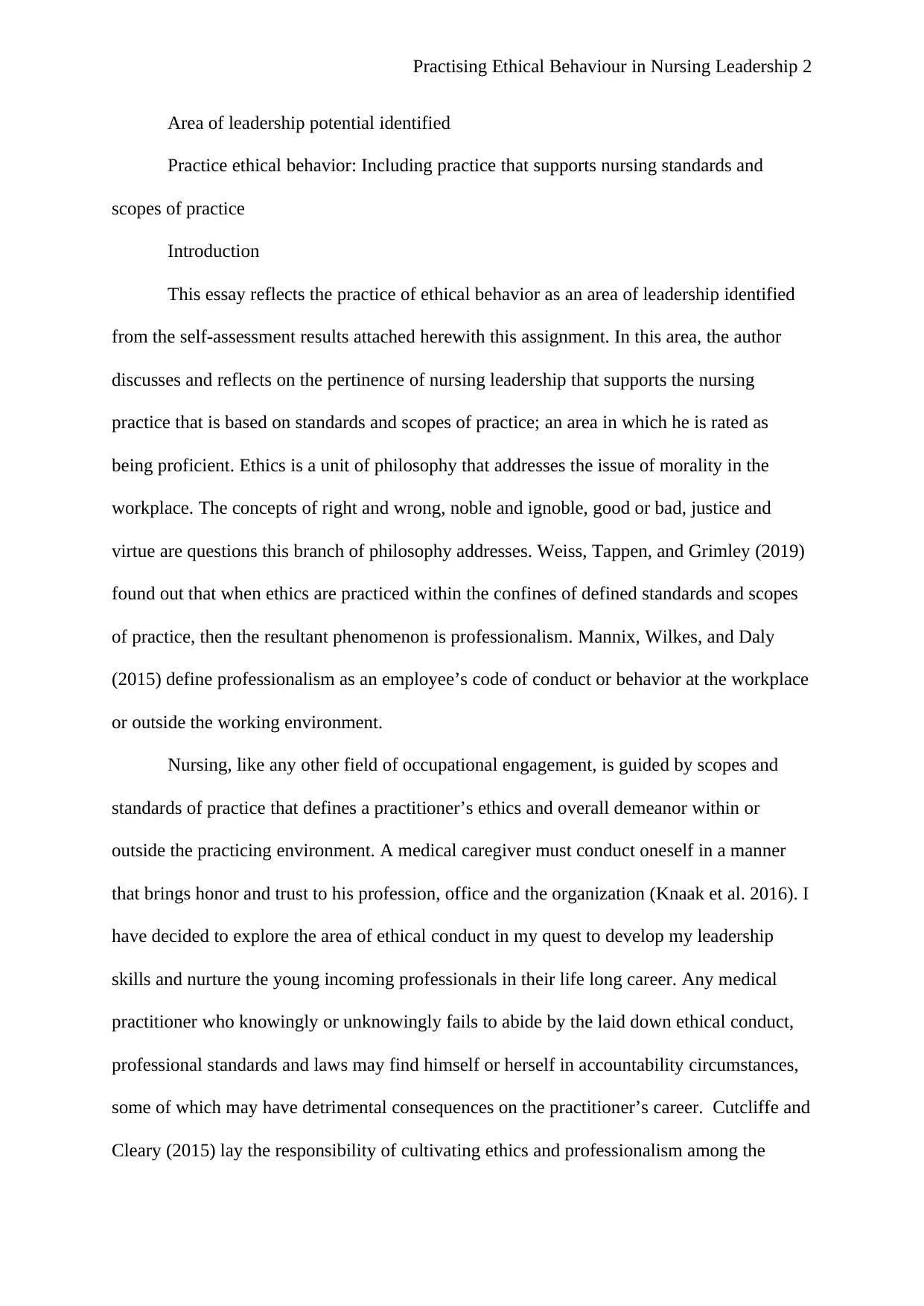
Practising Ethical Behaviour in Nursing Leadership 2
Area of leadership potential identified
Practice ethical behavior: Including practice that supports nursing standards and
scopes of practice
Introduction
This essay reflects the practice of ethical behavior as an area of leadership identified
from the self-assessment results attached herewith this assignment. In this area, the author
discusses and reflects on the pertinence of nursing leadership that supports the nursing
practice that is based on standards and scopes of practice; an area in which he is rated as
being proficient. Ethics is a unit of philosophy that addresses the issue of morality in the
workplace. The concepts of right and wrong, noble and ignoble, good or bad, justice and
virtue are questions this branch of philosophy addresses. Weiss, Tappen, and Grimley (2019)
found out that when ethics are practiced within the confines of defined standards and scopes
of practice, then the resultant phenomenon is professionalism. Mannix, Wilkes, and Daly
(2015) define professionalism as an employee’s code of conduct or behavior at the workplace
or outside the working environment.
Nursing, like any other field of occupational engagement, is guided by scopes and
standards of practice that defines a practitioner’s ethics and overall demeanor within or
outside the practicing environment. A medical caregiver must conduct oneself in a manner
that brings honor and trust to his profession, office and the organization (Knaak et al. 2016). I
have decided to explore the area of ethical conduct in my quest to develop my leadership
skills and nurture the young incoming professionals in their life long career. Any medical
practitioner who knowingly or unknowingly fails to abide by the laid down ethical conduct,
professional standards and laws may find himself or herself in accountability circumstances,
some of which may have detrimental consequences on the practitioner’s career. Cutcliffe and
Cleary (2015) lay the responsibility of cultivating ethics and professionalism among the
Area of leadership potential identified
Practice ethical behavior: Including practice that supports nursing standards and
scopes of practice
Introduction
This essay reflects the practice of ethical behavior as an area of leadership identified
from the self-assessment results attached herewith this assignment. In this area, the author
discusses and reflects on the pertinence of nursing leadership that supports the nursing
practice that is based on standards and scopes of practice; an area in which he is rated as
being proficient. Ethics is a unit of philosophy that addresses the issue of morality in the
workplace. The concepts of right and wrong, noble and ignoble, good or bad, justice and
virtue are questions this branch of philosophy addresses. Weiss, Tappen, and Grimley (2019)
found out that when ethics are practiced within the confines of defined standards and scopes
of practice, then the resultant phenomenon is professionalism. Mannix, Wilkes, and Daly
(2015) define professionalism as an employee’s code of conduct or behavior at the workplace
or outside the working environment.
Nursing, like any other field of occupational engagement, is guided by scopes and
standards of practice that defines a practitioner’s ethics and overall demeanor within or
outside the practicing environment. A medical caregiver must conduct oneself in a manner
that brings honor and trust to his profession, office and the organization (Knaak et al. 2016). I
have decided to explore the area of ethical conduct in my quest to develop my leadership
skills and nurture the young incoming professionals in their life long career. Any medical
practitioner who knowingly or unknowingly fails to abide by the laid down ethical conduct,
professional standards and laws may find himself or herself in accountability circumstances,
some of which may have detrimental consequences on the practitioner’s career. Cutcliffe and
Cleary (2015) lay the responsibility of cultivating ethics and professionalism among the
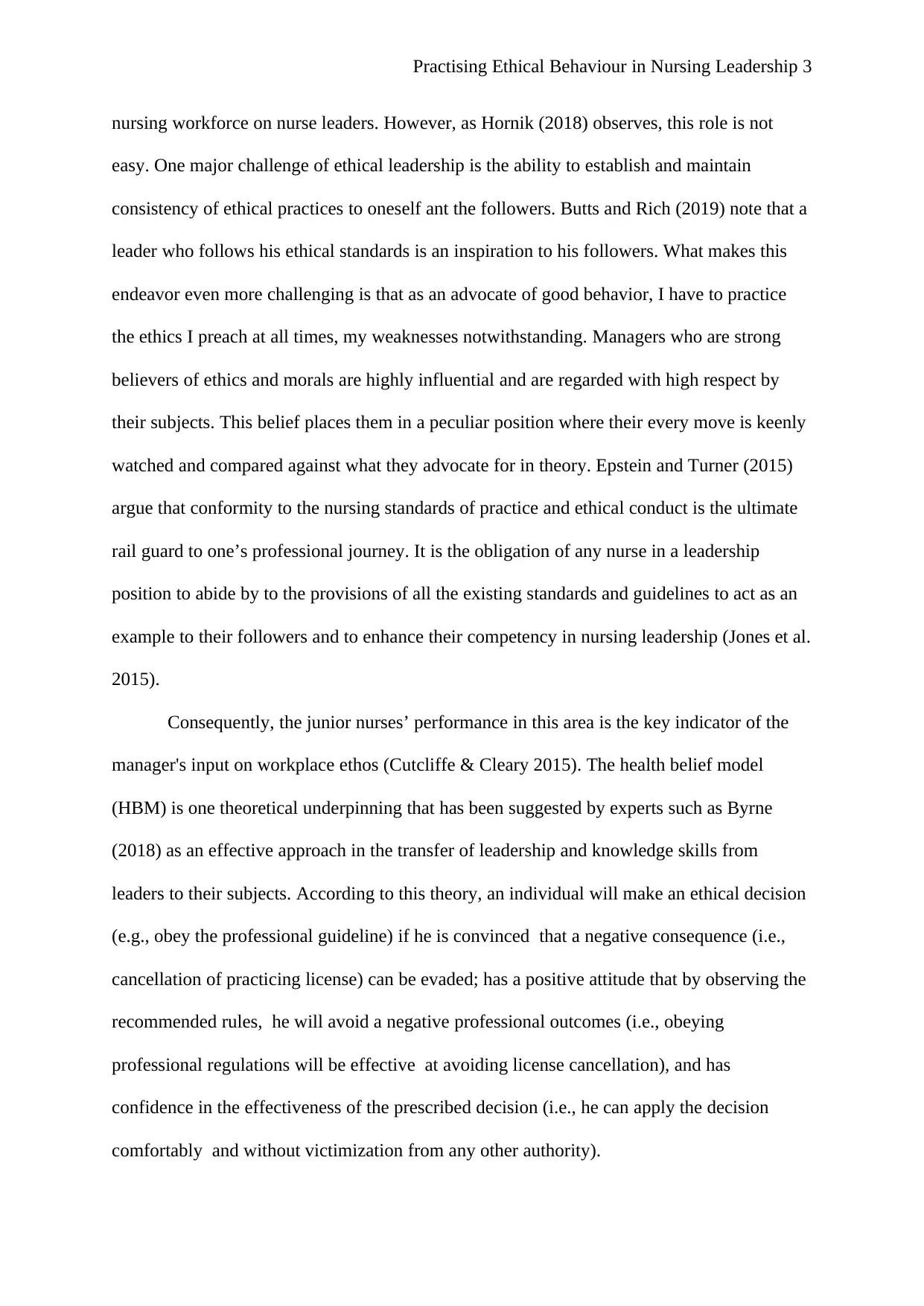
Practising Ethical Behaviour in Nursing Leadership 3
nursing workforce on nurse leaders. However, as Hornik (2018) observes, this role is not
easy. One major challenge of ethical leadership is the ability to establish and maintain
consistency of ethical practices to oneself ant the followers. Butts and Rich (2019) note that a
leader who follows his ethical standards is an inspiration to his followers. What makes this
endeavor even more challenging is that as an advocate of good behavior, I have to practice
the ethics I preach at all times, my weaknesses notwithstanding. Managers who are strong
believers of ethics and morals are highly influential and are regarded with high respect by
their subjects. This belief places them in a peculiar position where their every move is keenly
watched and compared against what they advocate for in theory. Epstein and Turner (2015)
argue that conformity to the nursing standards of practice and ethical conduct is the ultimate
rail guard to one’s professional journey. It is the obligation of any nurse in a leadership
position to abide by to the provisions of all the existing standards and guidelines to act as an
example to their followers and to enhance their competency in nursing leadership (Jones et al.
2015).
Consequently, the junior nurses’ performance in this area is the key indicator of the
manager's input on workplace ethos (Cutcliffe & Cleary 2015). The health belief model
(HBM) is one theoretical underpinning that has been suggested by experts such as Byrne
(2018) as an effective approach in the transfer of leadership and knowledge skills from
leaders to their subjects. According to this theory, an individual will make an ethical decision
(e.g., obey the professional guideline) if he is convinced that a negative consequence (i.e.,
cancellation of practicing license) can be evaded; has a positive attitude that by observing the
recommended rules, he will avoid a negative professional outcomes (i.e., obeying
professional regulations will be effective at avoiding license cancellation), and has
confidence in the effectiveness of the prescribed decision (i.e., he can apply the decision
comfortably and without victimization from any other authority).
nursing workforce on nurse leaders. However, as Hornik (2018) observes, this role is not
easy. One major challenge of ethical leadership is the ability to establish and maintain
consistency of ethical practices to oneself ant the followers. Butts and Rich (2019) note that a
leader who follows his ethical standards is an inspiration to his followers. What makes this
endeavor even more challenging is that as an advocate of good behavior, I have to practice
the ethics I preach at all times, my weaknesses notwithstanding. Managers who are strong
believers of ethics and morals are highly influential and are regarded with high respect by
their subjects. This belief places them in a peculiar position where their every move is keenly
watched and compared against what they advocate for in theory. Epstein and Turner (2015)
argue that conformity to the nursing standards of practice and ethical conduct is the ultimate
rail guard to one’s professional journey. It is the obligation of any nurse in a leadership
position to abide by to the provisions of all the existing standards and guidelines to act as an
example to their followers and to enhance their competency in nursing leadership (Jones et al.
2015).
Consequently, the junior nurses’ performance in this area is the key indicator of the
manager's input on workplace ethos (Cutcliffe & Cleary 2015). The health belief model
(HBM) is one theoretical underpinning that has been suggested by experts such as Byrne
(2018) as an effective approach in the transfer of leadership and knowledge skills from
leaders to their subjects. According to this theory, an individual will make an ethical decision
(e.g., obey the professional guideline) if he is convinced that a negative consequence (i.e.,
cancellation of practicing license) can be evaded; has a positive attitude that by observing the
recommended rules, he will avoid a negative professional outcomes (i.e., obeying
professional regulations will be effective at avoiding license cancellation), and has
confidence in the effectiveness of the prescribed decision (i.e., he can apply the decision
comfortably and without victimization from any other authority).
⊘ This is a preview!⊘
Do you want full access?
Subscribe today to unlock all pages.

Trusted by 1+ million students worldwide
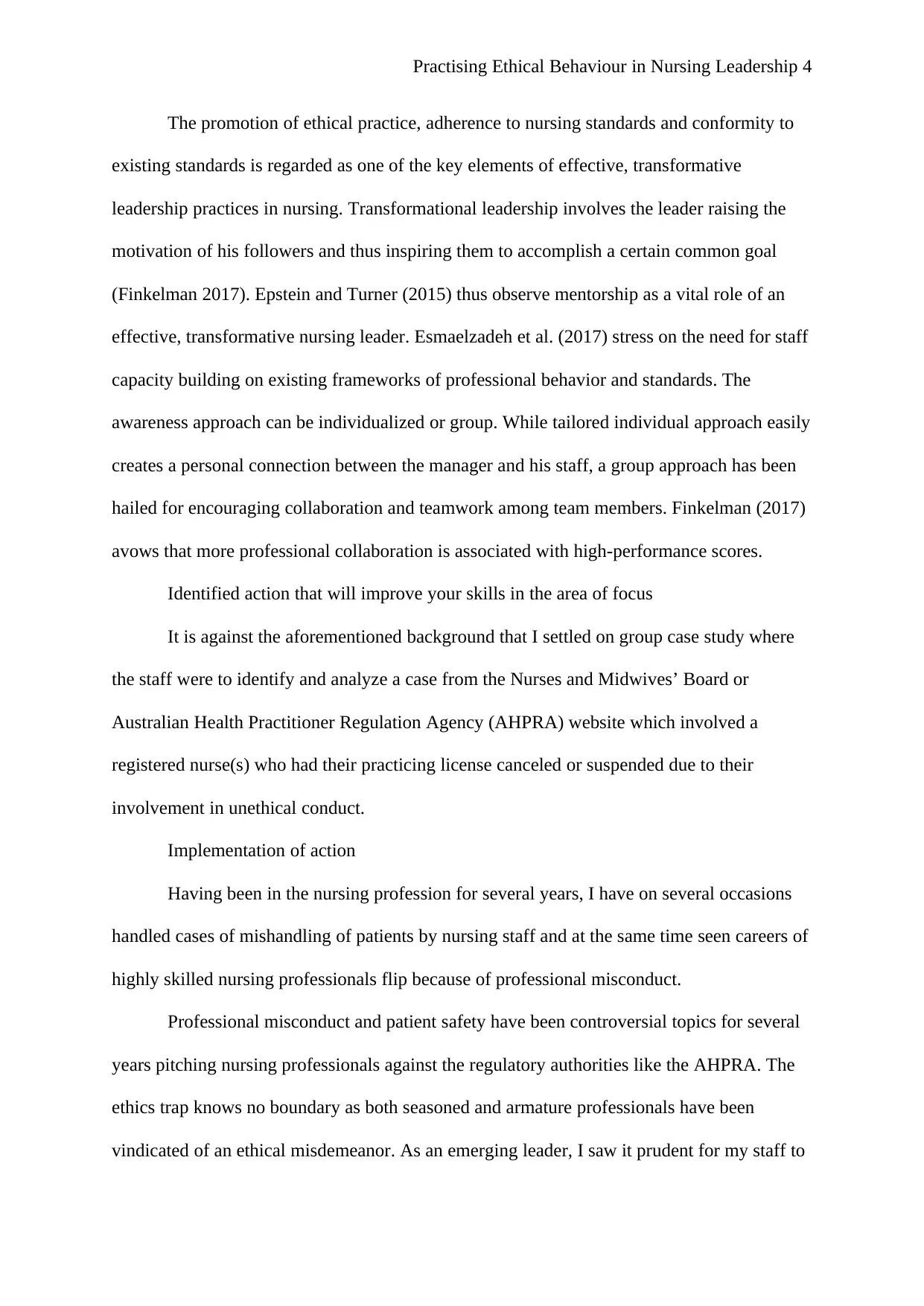
Practising Ethical Behaviour in Nursing Leadership 4
The promotion of ethical practice, adherence to nursing standards and conformity to
existing standards is regarded as one of the key elements of effective, transformative
leadership practices in nursing. Transformational leadership involves the leader raising the
motivation of his followers and thus inspiring them to accomplish a certain common goal
(Finkelman 2017). Epstein and Turner (2015) thus observe mentorship as a vital role of an
effective, transformative nursing leader. Esmaelzadeh et al. (2017) stress on the need for staff
capacity building on existing frameworks of professional behavior and standards. The
awareness approach can be individualized or group. While tailored individual approach easily
creates a personal connection between the manager and his staff, a group approach has been
hailed for encouraging collaboration and teamwork among team members. Finkelman (2017)
avows that more professional collaboration is associated with high-performance scores.
Identified action that will improve your skills in the area of focus
It is against the aforementioned background that I settled on group case study where
the staff were to identify and analyze a case from the Nurses and Midwives’ Board or
Australian Health Practitioner Regulation Agency (AHPRA) website which involved a
registered nurse(s) who had their practicing license canceled or suspended due to their
involvement in unethical conduct.
Implementation of action
Having been in the nursing profession for several years, I have on several occasions
handled cases of mishandling of patients by nursing staff and at the same time seen careers of
highly skilled nursing professionals flip because of professional misconduct.
Professional misconduct and patient safety have been controversial topics for several
years pitching nursing professionals against the regulatory authorities like the AHPRA. The
ethics trap knows no boundary as both seasoned and armature professionals have been
vindicated of an ethical misdemeanor. As an emerging leader, I saw it prudent for my staff to
The promotion of ethical practice, adherence to nursing standards and conformity to
existing standards is regarded as one of the key elements of effective, transformative
leadership practices in nursing. Transformational leadership involves the leader raising the
motivation of his followers and thus inspiring them to accomplish a certain common goal
(Finkelman 2017). Epstein and Turner (2015) thus observe mentorship as a vital role of an
effective, transformative nursing leader. Esmaelzadeh et al. (2017) stress on the need for staff
capacity building on existing frameworks of professional behavior and standards. The
awareness approach can be individualized or group. While tailored individual approach easily
creates a personal connection between the manager and his staff, a group approach has been
hailed for encouraging collaboration and teamwork among team members. Finkelman (2017)
avows that more professional collaboration is associated with high-performance scores.
Identified action that will improve your skills in the area of focus
It is against the aforementioned background that I settled on group case study where
the staff were to identify and analyze a case from the Nurses and Midwives’ Board or
Australian Health Practitioner Regulation Agency (AHPRA) website which involved a
registered nurse(s) who had their practicing license canceled or suspended due to their
involvement in unethical conduct.
Implementation of action
Having been in the nursing profession for several years, I have on several occasions
handled cases of mishandling of patients by nursing staff and at the same time seen careers of
highly skilled nursing professionals flip because of professional misconduct.
Professional misconduct and patient safety have been controversial topics for several
years pitching nursing professionals against the regulatory authorities like the AHPRA. The
ethics trap knows no boundary as both seasoned and armature professionals have been
vindicated of an ethical misdemeanor. As an emerging leader, I saw it prudent for my staff to
Paraphrase This Document
Need a fresh take? Get an instant paraphrase of this document with our AI Paraphraser
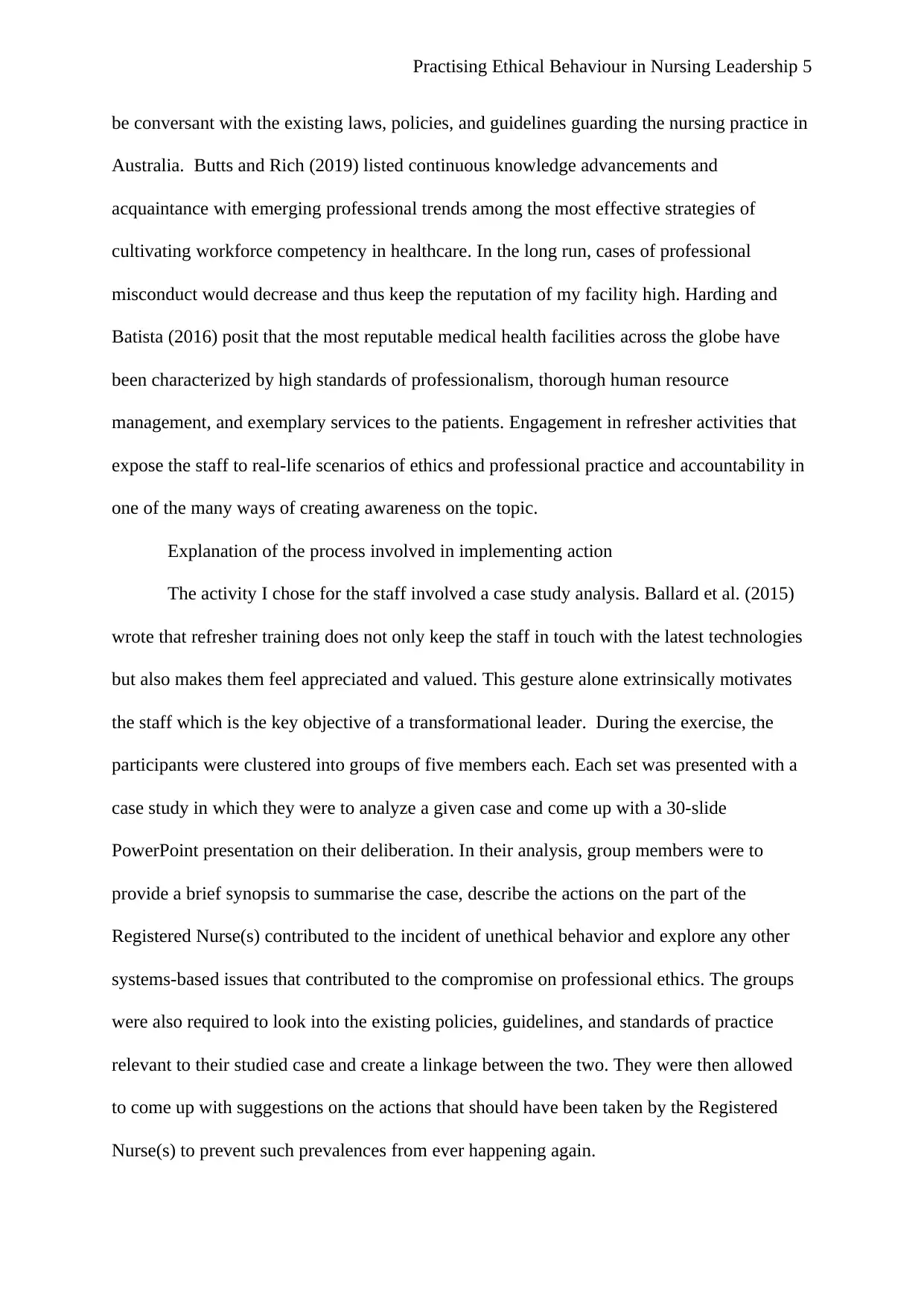
Practising Ethical Behaviour in Nursing Leadership 5
be conversant with the existing laws, policies, and guidelines guarding the nursing practice in
Australia. Butts and Rich (2019) listed continuous knowledge advancements and
acquaintance with emerging professional trends among the most effective strategies of
cultivating workforce competency in healthcare. In the long run, cases of professional
misconduct would decrease and thus keep the reputation of my facility high. Harding and
Batista (2016) posit that the most reputable medical health facilities across the globe have
been characterized by high standards of professionalism, thorough human resource
management, and exemplary services to the patients. Engagement in refresher activities that
expose the staff to real-life scenarios of ethics and professional practice and accountability in
one of the many ways of creating awareness on the topic.
Explanation of the process involved in implementing action
The activity I chose for the staff involved a case study analysis. Ballard et al. (2015)
wrote that refresher training does not only keep the staff in touch with the latest technologies
but also makes them feel appreciated and valued. This gesture alone extrinsically motivates
the staff which is the key objective of a transformational leader. During the exercise, the
participants were clustered into groups of five members each. Each set was presented with a
case study in which they were to analyze a given case and come up with a 30-slide
PowerPoint presentation on their deliberation. In their analysis, group members were to
provide a brief synopsis to summarise the case, describe the actions on the part of the
Registered Nurse(s) contributed to the incident of unethical behavior and explore any other
systems-based issues that contributed to the compromise on professional ethics. The groups
were also required to look into the existing policies, guidelines, and standards of practice
relevant to their studied case and create a linkage between the two. They were then allowed
to come up with suggestions on the actions that should have been taken by the Registered
Nurse(s) to prevent such prevalences from ever happening again.
be conversant with the existing laws, policies, and guidelines guarding the nursing practice in
Australia. Butts and Rich (2019) listed continuous knowledge advancements and
acquaintance with emerging professional trends among the most effective strategies of
cultivating workforce competency in healthcare. In the long run, cases of professional
misconduct would decrease and thus keep the reputation of my facility high. Harding and
Batista (2016) posit that the most reputable medical health facilities across the globe have
been characterized by high standards of professionalism, thorough human resource
management, and exemplary services to the patients. Engagement in refresher activities that
expose the staff to real-life scenarios of ethics and professional practice and accountability in
one of the many ways of creating awareness on the topic.
Explanation of the process involved in implementing action
The activity I chose for the staff involved a case study analysis. Ballard et al. (2015)
wrote that refresher training does not only keep the staff in touch with the latest technologies
but also makes them feel appreciated and valued. This gesture alone extrinsically motivates
the staff which is the key objective of a transformational leader. During the exercise, the
participants were clustered into groups of five members each. Each set was presented with a
case study in which they were to analyze a given case and come up with a 30-slide
PowerPoint presentation on their deliberation. In their analysis, group members were to
provide a brief synopsis to summarise the case, describe the actions on the part of the
Registered Nurse(s) contributed to the incident of unethical behavior and explore any other
systems-based issues that contributed to the compromise on professional ethics. The groups
were also required to look into the existing policies, guidelines, and standards of practice
relevant to their studied case and create a linkage between the two. They were then allowed
to come up with suggestions on the actions that should have been taken by the Registered
Nurse(s) to prevent such prevalences from ever happening again.
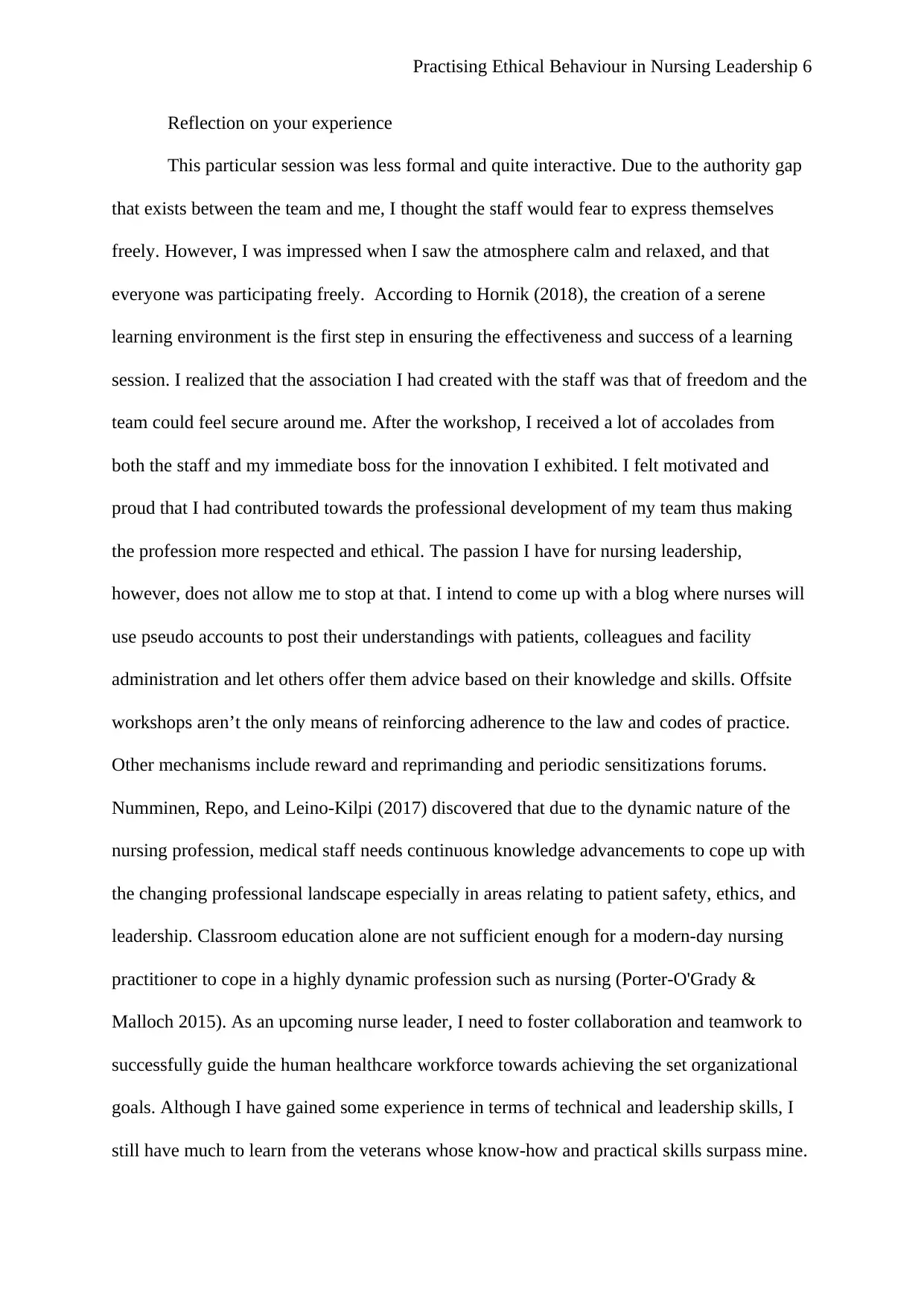
Practising Ethical Behaviour in Nursing Leadership 6
Reflection on your experience
This particular session was less formal and quite interactive. Due to the authority gap
that exists between the team and me, I thought the staff would fear to express themselves
freely. However, I was impressed when I saw the atmosphere calm and relaxed, and that
everyone was participating freely. According to Hornik (2018), the creation of a serene
learning environment is the first step in ensuring the effectiveness and success of a learning
session. I realized that the association I had created with the staff was that of freedom and the
team could feel secure around me. After the workshop, I received a lot of accolades from
both the staff and my immediate boss for the innovation I exhibited. I felt motivated and
proud that I had contributed towards the professional development of my team thus making
the profession more respected and ethical. The passion I have for nursing leadership,
however, does not allow me to stop at that. I intend to come up with a blog where nurses will
use pseudo accounts to post their understandings with patients, colleagues and facility
administration and let others offer them advice based on their knowledge and skills. Offsite
workshops aren’t the only means of reinforcing adherence to the law and codes of practice.
Other mechanisms include reward and reprimanding and periodic sensitizations forums.
Numminen, Repo, and Leino-Kilpi (2017) discovered that due to the dynamic nature of the
nursing profession, medical staff needs continuous knowledge advancements to cope up with
the changing professional landscape especially in areas relating to patient safety, ethics, and
leadership. Classroom education alone are not sufficient enough for a modern-day nursing
practitioner to cope in a highly dynamic profession such as nursing (Porter-O'Grady &
Malloch 2015). As an upcoming nurse leader, I need to foster collaboration and teamwork to
successfully guide the human healthcare workforce towards achieving the set organizational
goals. Although I have gained some experience in terms of technical and leadership skills, I
still have much to learn from the veterans whose know-how and practical skills surpass mine.
Reflection on your experience
This particular session was less formal and quite interactive. Due to the authority gap
that exists between the team and me, I thought the staff would fear to express themselves
freely. However, I was impressed when I saw the atmosphere calm and relaxed, and that
everyone was participating freely. According to Hornik (2018), the creation of a serene
learning environment is the first step in ensuring the effectiveness and success of a learning
session. I realized that the association I had created with the staff was that of freedom and the
team could feel secure around me. After the workshop, I received a lot of accolades from
both the staff and my immediate boss for the innovation I exhibited. I felt motivated and
proud that I had contributed towards the professional development of my team thus making
the profession more respected and ethical. The passion I have for nursing leadership,
however, does not allow me to stop at that. I intend to come up with a blog where nurses will
use pseudo accounts to post their understandings with patients, colleagues and facility
administration and let others offer them advice based on their knowledge and skills. Offsite
workshops aren’t the only means of reinforcing adherence to the law and codes of practice.
Other mechanisms include reward and reprimanding and periodic sensitizations forums.
Numminen, Repo, and Leino-Kilpi (2017) discovered that due to the dynamic nature of the
nursing profession, medical staff needs continuous knowledge advancements to cope up with
the changing professional landscape especially in areas relating to patient safety, ethics, and
leadership. Classroom education alone are not sufficient enough for a modern-day nursing
practitioner to cope in a highly dynamic profession such as nursing (Porter-O'Grady &
Malloch 2015). As an upcoming nurse leader, I need to foster collaboration and teamwork to
successfully guide the human healthcare workforce towards achieving the set organizational
goals. Although I have gained some experience in terms of technical and leadership skills, I
still have much to learn from the veterans whose know-how and practical skills surpass mine.
⊘ This is a preview!⊘
Do you want full access?
Subscribe today to unlock all pages.

Trusted by 1+ million students worldwide
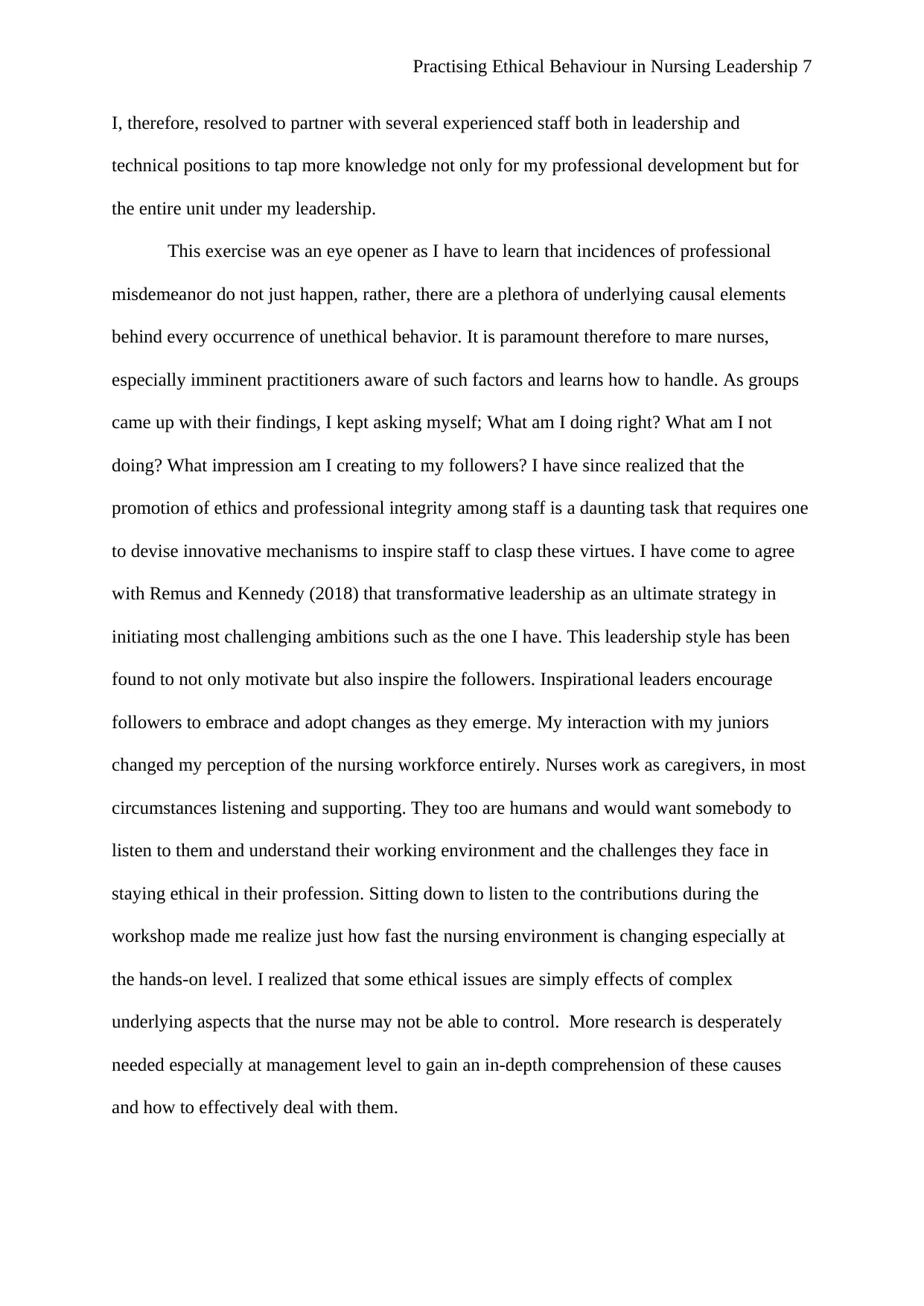
Practising Ethical Behaviour in Nursing Leadership 7
I, therefore, resolved to partner with several experienced staff both in leadership and
technical positions to tap more knowledge not only for my professional development but for
the entire unit under my leadership.
This exercise was an eye opener as I have to learn that incidences of professional
misdemeanor do not just happen, rather, there are a plethora of underlying causal elements
behind every occurrence of unethical behavior. It is paramount therefore to mare nurses,
especially imminent practitioners aware of such factors and learns how to handle. As groups
came up with their findings, I kept asking myself; What am I doing right? What am I not
doing? What impression am I creating to my followers? I have since realized that the
promotion of ethics and professional integrity among staff is a daunting task that requires one
to devise innovative mechanisms to inspire staff to clasp these virtues. I have come to agree
with Remus and Kennedy (2018) that transformative leadership as an ultimate strategy in
initiating most challenging ambitions such as the one I have. This leadership style has been
found to not only motivate but also inspire the followers. Inspirational leaders encourage
followers to embrace and adopt changes as they emerge. My interaction with my juniors
changed my perception of the nursing workforce entirely. Nurses work as caregivers, in most
circumstances listening and supporting. They too are humans and would want somebody to
listen to them and understand their working environment and the challenges they face in
staying ethical in their profession. Sitting down to listen to the contributions during the
workshop made me realize just how fast the nursing environment is changing especially at
the hands-on level. I realized that some ethical issues are simply effects of complex
underlying aspects that the nurse may not be able to control. More research is desperately
needed especially at management level to gain an in-depth comprehension of these causes
and how to effectively deal with them.
I, therefore, resolved to partner with several experienced staff both in leadership and
technical positions to tap more knowledge not only for my professional development but for
the entire unit under my leadership.
This exercise was an eye opener as I have to learn that incidences of professional
misdemeanor do not just happen, rather, there are a plethora of underlying causal elements
behind every occurrence of unethical behavior. It is paramount therefore to mare nurses,
especially imminent practitioners aware of such factors and learns how to handle. As groups
came up with their findings, I kept asking myself; What am I doing right? What am I not
doing? What impression am I creating to my followers? I have since realized that the
promotion of ethics and professional integrity among staff is a daunting task that requires one
to devise innovative mechanisms to inspire staff to clasp these virtues. I have come to agree
with Remus and Kennedy (2018) that transformative leadership as an ultimate strategy in
initiating most challenging ambitions such as the one I have. This leadership style has been
found to not only motivate but also inspire the followers. Inspirational leaders encourage
followers to embrace and adopt changes as they emerge. My interaction with my juniors
changed my perception of the nursing workforce entirely. Nurses work as caregivers, in most
circumstances listening and supporting. They too are humans and would want somebody to
listen to them and understand their working environment and the challenges they face in
staying ethical in their profession. Sitting down to listen to the contributions during the
workshop made me realize just how fast the nursing environment is changing especially at
the hands-on level. I realized that some ethical issues are simply effects of complex
underlying aspects that the nurse may not be able to control. More research is desperately
needed especially at management level to gain an in-depth comprehension of these causes
and how to effectively deal with them.
Paraphrase This Document
Need a fresh take? Get an instant paraphrase of this document with our AI Paraphraser
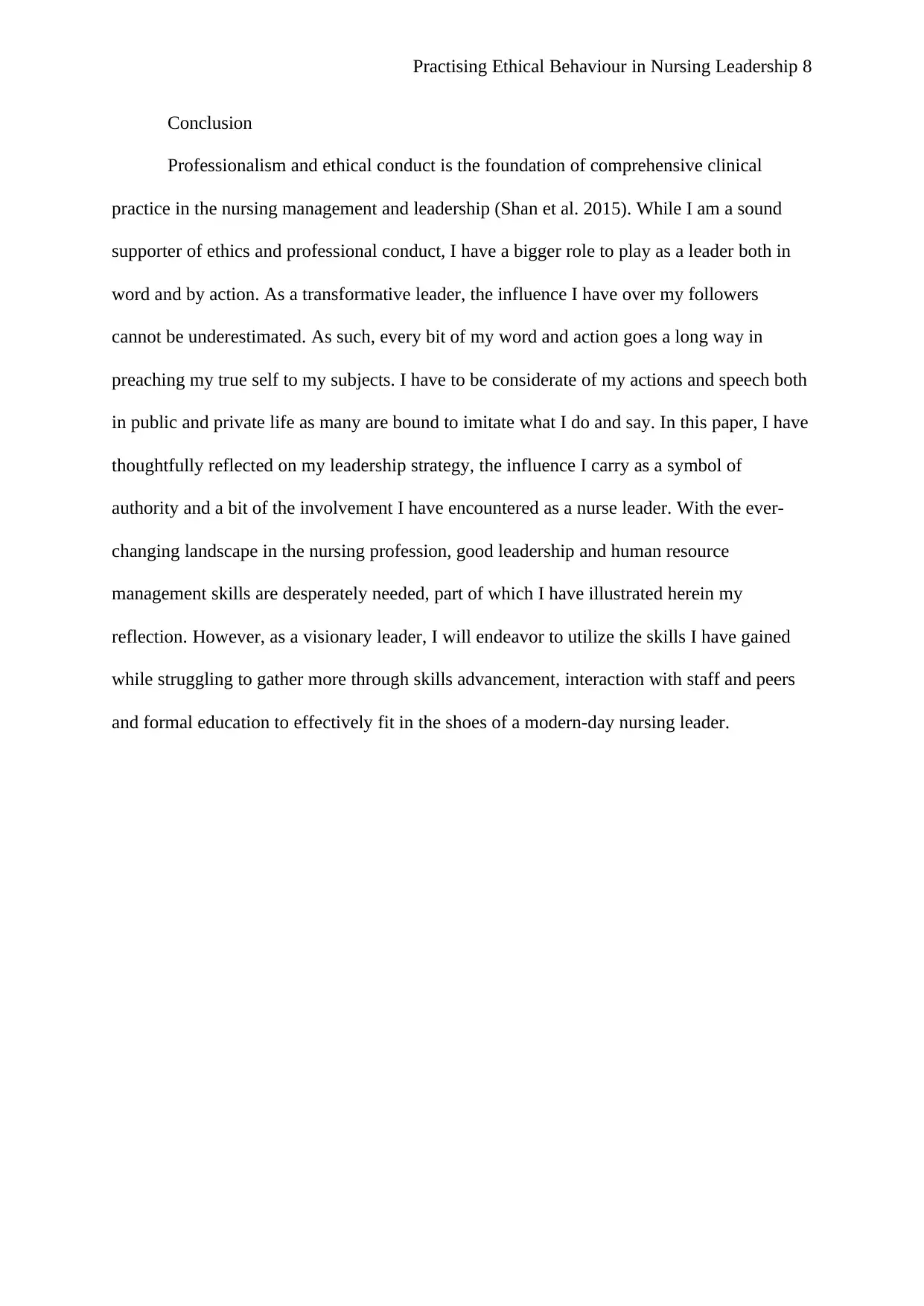
Practising Ethical Behaviour in Nursing Leadership 8
Conclusion
Professionalism and ethical conduct is the foundation of comprehensive clinical
practice in the nursing management and leadership (Shan et al. 2015). While I am a sound
supporter of ethics and professional conduct, I have a bigger role to play as a leader both in
word and by action. As a transformative leader, the influence I have over my followers
cannot be underestimated. As such, every bit of my word and action goes a long way in
preaching my true self to my subjects. I have to be considerate of my actions and speech both
in public and private life as many are bound to imitate what I do and say. In this paper, I have
thoughtfully reflected on my leadership strategy, the influence I carry as a symbol of
authority and a bit of the involvement I have encountered as a nurse leader. With the ever-
changing landscape in the nursing profession, good leadership and human resource
management skills are desperately needed, part of which I have illustrated herein my
reflection. However, as a visionary leader, I will endeavor to utilize the skills I have gained
while struggling to gather more through skills advancement, interaction with staff and peers
and formal education to effectively fit in the shoes of a modern-day nursing leader.
Conclusion
Professionalism and ethical conduct is the foundation of comprehensive clinical
practice in the nursing management and leadership (Shan et al. 2015). While I am a sound
supporter of ethics and professional conduct, I have a bigger role to play as a leader both in
word and by action. As a transformative leader, the influence I have over my followers
cannot be underestimated. As such, every bit of my word and action goes a long way in
preaching my true self to my subjects. I have to be considerate of my actions and speech both
in public and private life as many are bound to imitate what I do and say. In this paper, I have
thoughtfully reflected on my leadership strategy, the influence I carry as a symbol of
authority and a bit of the involvement I have encountered as a nurse leader. With the ever-
changing landscape in the nursing profession, good leadership and human resource
management skills are desperately needed, part of which I have illustrated herein my
reflection. However, as a visionary leader, I will endeavor to utilize the skills I have gained
while struggling to gather more through skills advancement, interaction with staff and peers
and formal education to effectively fit in the shoes of a modern-day nursing leader.
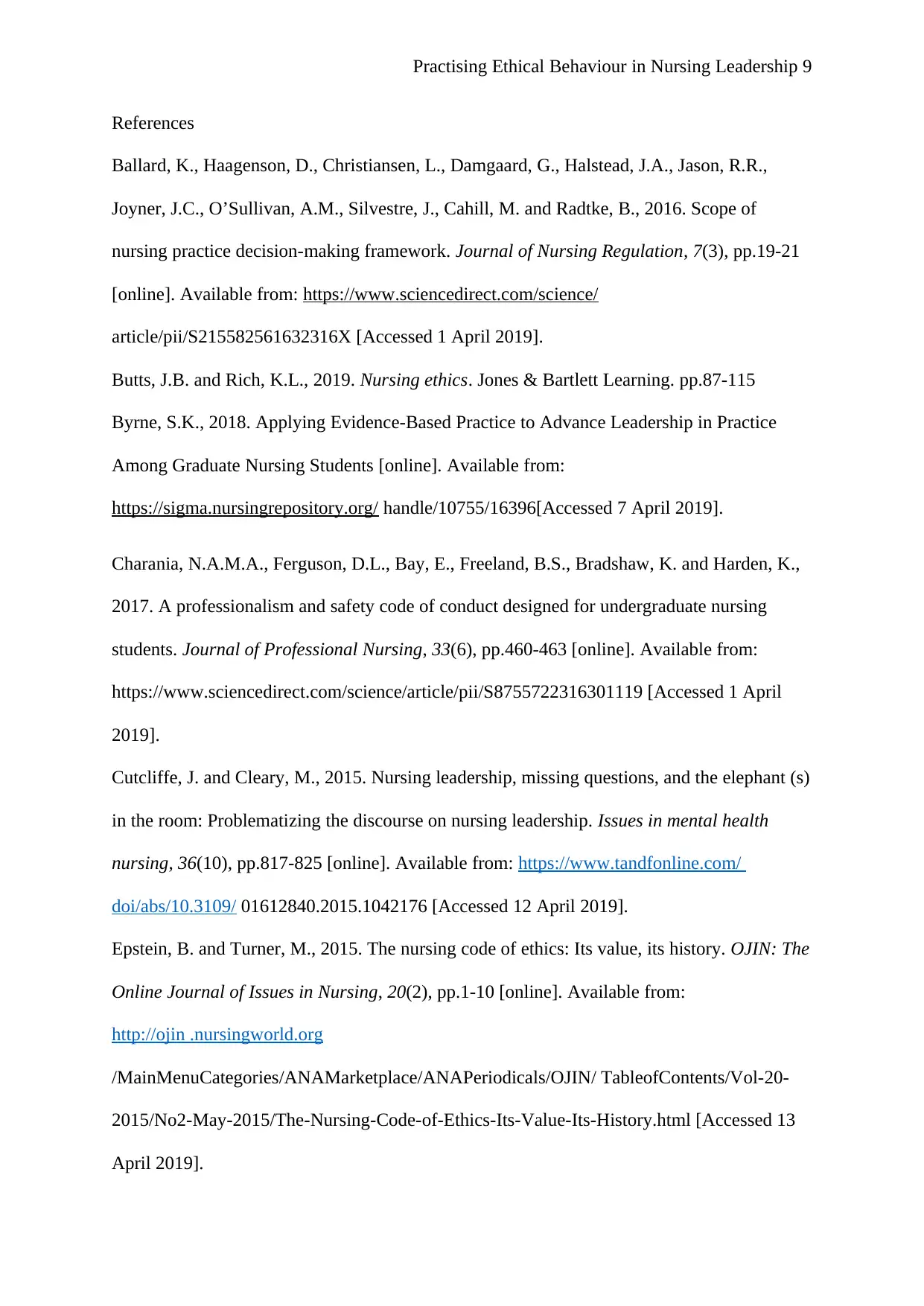
Practising Ethical Behaviour in Nursing Leadership 9
References
Ballard, K., Haagenson, D., Christiansen, L., Damgaard, G., Halstead, J.A., Jason, R.R.,
Joyner, J.C., O’Sullivan, A.M., Silvestre, J., Cahill, M. and Radtke, B., 2016. Scope of
nursing practice decision-making framework. Journal of Nursing Regulation, 7(3), pp.19-21
[online]. Available from: https://www.sciencedirect.com/science/
article/pii/S215582561632316X [Accessed 1 April 2019].
Butts, J.B. and Rich, K.L., 2019. Nursing ethics. Jones & Bartlett Learning. pp.87-115
Byrne, S.K., 2018. Applying Evidence-Based Practice to Advance Leadership in Practice
Among Graduate Nursing Students [online]. Available from:
https://sigma.nursingrepository.org/ handle/10755/16396[Accessed 7 April 2019].
Charania, N.A.M.A., Ferguson, D.L., Bay, E., Freeland, B.S., Bradshaw, K. and Harden, K.,
2017. A professionalism and safety code of conduct designed for undergraduate nursing
students. Journal of Professional Nursing, 33(6), pp.460-463 [online]. Available from:
https://www.sciencedirect.com/science/article/pii/S8755722316301119 [Accessed 1 April
2019].
Cutcliffe, J. and Cleary, M., 2015. Nursing leadership, missing questions, and the elephant (s)
in the room: Problematizing the discourse on nursing leadership. Issues in mental health
nursing, 36(10), pp.817-825 [online]. Available from: https://www.tandfonline.com/
doi/abs/10.3109/ 01612840.2015.1042176 [Accessed 12 April 2019].
Epstein, B. and Turner, M., 2015. The nursing code of ethics: Its value, its history. OJIN: The
Online Journal of Issues in Nursing, 20(2), pp.1-10 [online]. Available from:
http://ojin .nursingworld.org
/MainMenuCategories/ANAMarketplace/ANAPeriodicals/OJIN/ TableofContents/Vol-20-
2015/No2-May-2015/The-Nursing-Code-of-Ethics-Its-Value-Its-History.html [Accessed 13
April 2019].
References
Ballard, K., Haagenson, D., Christiansen, L., Damgaard, G., Halstead, J.A., Jason, R.R.,
Joyner, J.C., O’Sullivan, A.M., Silvestre, J., Cahill, M. and Radtke, B., 2016. Scope of
nursing practice decision-making framework. Journal of Nursing Regulation, 7(3), pp.19-21
[online]. Available from: https://www.sciencedirect.com/science/
article/pii/S215582561632316X [Accessed 1 April 2019].
Butts, J.B. and Rich, K.L., 2019. Nursing ethics. Jones & Bartlett Learning. pp.87-115
Byrne, S.K., 2018. Applying Evidence-Based Practice to Advance Leadership in Practice
Among Graduate Nursing Students [online]. Available from:
https://sigma.nursingrepository.org/ handle/10755/16396[Accessed 7 April 2019].
Charania, N.A.M.A., Ferguson, D.L., Bay, E., Freeland, B.S., Bradshaw, K. and Harden, K.,
2017. A professionalism and safety code of conduct designed for undergraduate nursing
students. Journal of Professional Nursing, 33(6), pp.460-463 [online]. Available from:
https://www.sciencedirect.com/science/article/pii/S8755722316301119 [Accessed 1 April
2019].
Cutcliffe, J. and Cleary, M., 2015. Nursing leadership, missing questions, and the elephant (s)
in the room: Problematizing the discourse on nursing leadership. Issues in mental health
nursing, 36(10), pp.817-825 [online]. Available from: https://www.tandfonline.com/
doi/abs/10.3109/ 01612840.2015.1042176 [Accessed 12 April 2019].
Epstein, B. and Turner, M., 2015. The nursing code of ethics: Its value, its history. OJIN: The
Online Journal of Issues in Nursing, 20(2), pp.1-10 [online]. Available from:
http://ojin .nursingworld.org
/MainMenuCategories/ANAMarketplace/ANAPeriodicals/OJIN/ TableofContents/Vol-20-
2015/No2-May-2015/The-Nursing-Code-of-Ethics-Its-Value-Its-History.html [Accessed 13
April 2019].
⊘ This is a preview!⊘
Do you want full access?
Subscribe today to unlock all pages.

Trusted by 1+ million students worldwide
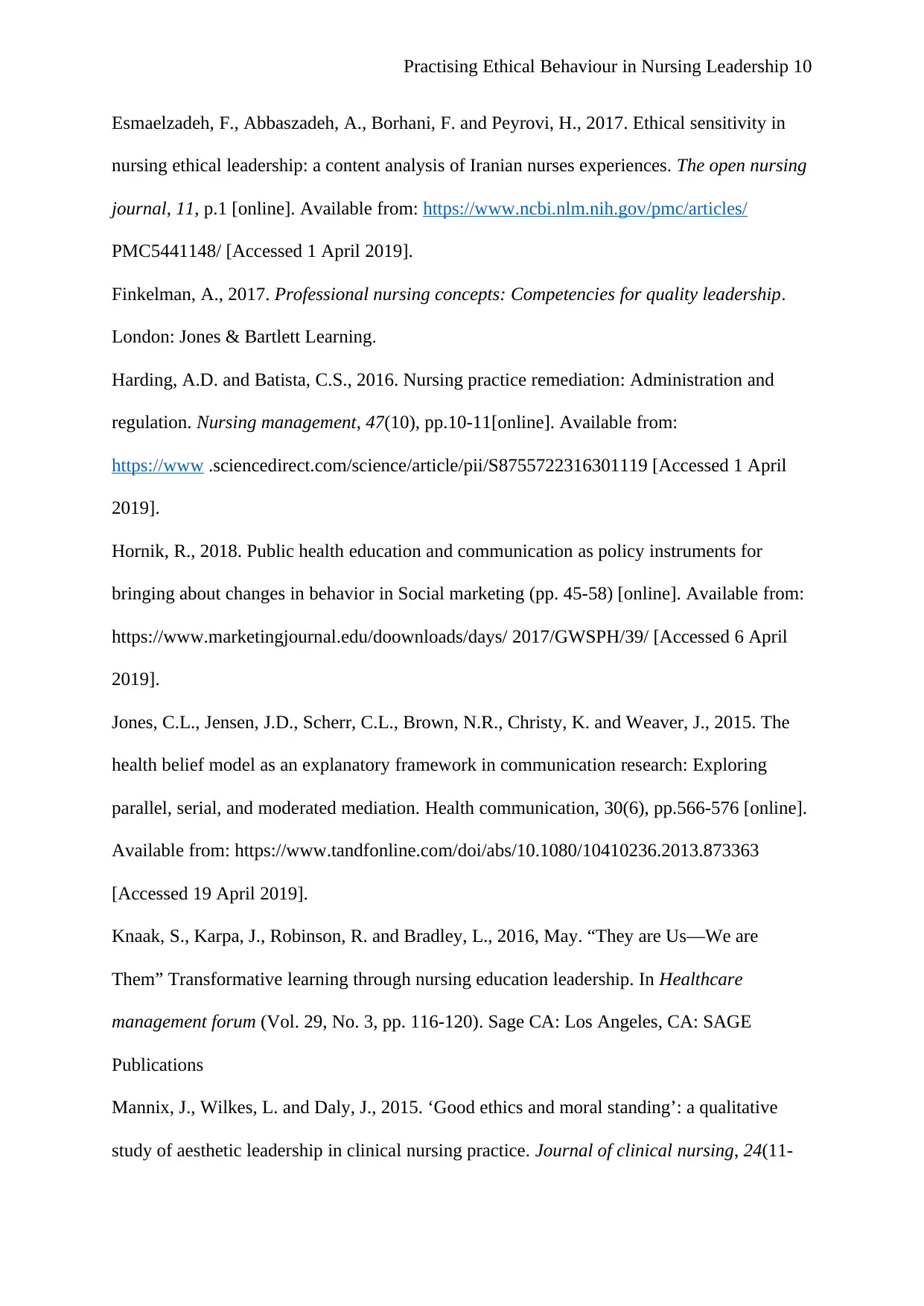
Practising Ethical Behaviour in Nursing Leadership 10
Esmaelzadeh, F., Abbaszadeh, A., Borhani, F. and Peyrovi, H., 2017. Ethical sensitivity in
nursing ethical leadership: a content analysis of Iranian nurses experiences. The open nursing
journal, 11, p.1 [online]. Available from: https://www.ncbi.nlm.nih.gov/pmc/articles/
PMC5441148/ [Accessed 1 April 2019].
Finkelman, A., 2017. Professional nursing concepts: Competencies for quality leadership.
London: Jones & Bartlett Learning.
Harding, A.D. and Batista, C.S., 2016. Nursing practice remediation: Administration and
regulation. Nursing management, 47(10), pp.10-11[online]. Available from:
https://www .sciencedirect.com/science/article/pii/S8755722316301119 [Accessed 1 April
2019].
Hornik, R., 2018. Public health education and communication as policy instruments for
bringing about changes in behavior in Social marketing (pp. 45-58) [online]. Available from:
https://www.marketingjournal.edu/doownloads/days/ 2017/GWSPH/39/ [Accessed 6 April
2019].
Jones, C.L., Jensen, J.D., Scherr, C.L., Brown, N.R., Christy, K. and Weaver, J., 2015. The
health belief model as an explanatory framework in communication research: Exploring
parallel, serial, and moderated mediation. Health communication, 30(6), pp.566-576 [online].
Available from: https://www.tandfonline.com/doi/abs/10.1080/10410236.2013.873363
[Accessed 19 April 2019].
Knaak, S., Karpa, J., Robinson, R. and Bradley, L., 2016, May. “They are Us—We are
Them” Transformative learning through nursing education leadership. In Healthcare
management forum (Vol. 29, No. 3, pp. 116-120). Sage CA: Los Angeles, CA: SAGE
Publications
Mannix, J., Wilkes, L. and Daly, J., 2015. ‘Good ethics and moral standing’: a qualitative
study of aesthetic leadership in clinical nursing practice. Journal of clinical nursing, 24(11-
Esmaelzadeh, F., Abbaszadeh, A., Borhani, F. and Peyrovi, H., 2017. Ethical sensitivity in
nursing ethical leadership: a content analysis of Iranian nurses experiences. The open nursing
journal, 11, p.1 [online]. Available from: https://www.ncbi.nlm.nih.gov/pmc/articles/
PMC5441148/ [Accessed 1 April 2019].
Finkelman, A., 2017. Professional nursing concepts: Competencies for quality leadership.
London: Jones & Bartlett Learning.
Harding, A.D. and Batista, C.S., 2016. Nursing practice remediation: Administration and
regulation. Nursing management, 47(10), pp.10-11[online]. Available from:
https://www .sciencedirect.com/science/article/pii/S8755722316301119 [Accessed 1 April
2019].
Hornik, R., 2018. Public health education and communication as policy instruments for
bringing about changes in behavior in Social marketing (pp. 45-58) [online]. Available from:
https://www.marketingjournal.edu/doownloads/days/ 2017/GWSPH/39/ [Accessed 6 April
2019].
Jones, C.L., Jensen, J.D., Scherr, C.L., Brown, N.R., Christy, K. and Weaver, J., 2015. The
health belief model as an explanatory framework in communication research: Exploring
parallel, serial, and moderated mediation. Health communication, 30(6), pp.566-576 [online].
Available from: https://www.tandfonline.com/doi/abs/10.1080/10410236.2013.873363
[Accessed 19 April 2019].
Knaak, S., Karpa, J., Robinson, R. and Bradley, L., 2016, May. “They are Us—We are
Them” Transformative learning through nursing education leadership. In Healthcare
management forum (Vol. 29, No. 3, pp. 116-120). Sage CA: Los Angeles, CA: SAGE
Publications
Mannix, J., Wilkes, L. and Daly, J., 2015. ‘Good ethics and moral standing’: a qualitative
study of aesthetic leadership in clinical nursing practice. Journal of clinical nursing, 24(11-
Paraphrase This Document
Need a fresh take? Get an instant paraphrase of this document with our AI Paraphraser
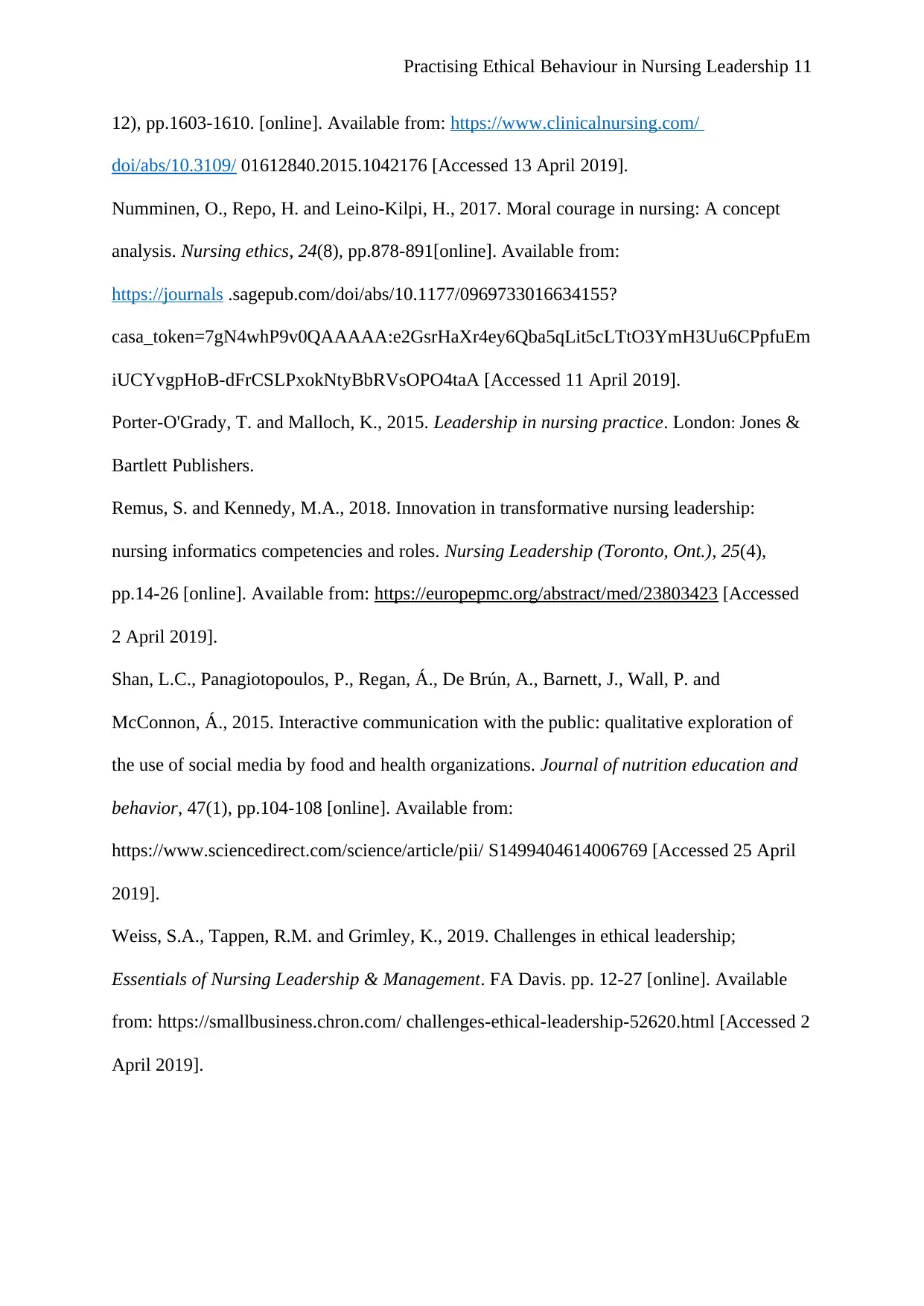
Practising Ethical Behaviour in Nursing Leadership 11
12), pp.1603-1610. [online]. Available from: https://www.clinicalnursing.com/
doi/abs/10.3109/ 01612840.2015.1042176 [Accessed 13 April 2019].
Numminen, O., Repo, H. and Leino-Kilpi, H., 2017. Moral courage in nursing: A concept
analysis. Nursing ethics, 24(8), pp.878-891[online]. Available from:
https://journals .sagepub.com/doi/abs/10.1177/0969733016634155?
casa_token=7gN4whP9v0QAAAAA:e2GsrHaXr4ey6Qba5qLit5cLTtO3YmH3Uu6CPpfuEm
iUCYvgpHoB-dFrCSLPxokNtyBbRVsOPO4taA [Accessed 11 April 2019].
Porter-O'Grady, T. and Malloch, K., 2015. Leadership in nursing practice. London: Jones &
Bartlett Publishers.
Remus, S. and Kennedy, M.A., 2018. Innovation in transformative nursing leadership:
nursing informatics competencies and roles. Nursing Leadership (Toronto, Ont.), 25(4),
pp.14-26 [online]. Available from: https://europepmc.org/abstract/med/23803423 [Accessed
2 April 2019].
Shan, L.C., Panagiotopoulos, P., Regan, Á., De Brún, A., Barnett, J., Wall, P. and
McConnon, Á., 2015. Interactive communication with the public: qualitative exploration of
the use of social media by food and health organizations. Journal of nutrition education and
behavior, 47(1), pp.104-108 [online]. Available from:
https://www.sciencedirect.com/science/article/pii/ S1499404614006769 [Accessed 25 April
2019].
Weiss, S.A., Tappen, R.M. and Grimley, K., 2019. Challenges in ethical leadership;
Essentials of Nursing Leadership & Management. FA Davis. pp. 12-27 [online]. Available
from: https://smallbusiness.chron.com/ challenges-ethical-leadership-52620.html [Accessed 2
April 2019].
12), pp.1603-1610. [online]. Available from: https://www.clinicalnursing.com/
doi/abs/10.3109/ 01612840.2015.1042176 [Accessed 13 April 2019].
Numminen, O., Repo, H. and Leino-Kilpi, H., 2017. Moral courage in nursing: A concept
analysis. Nursing ethics, 24(8), pp.878-891[online]. Available from:
https://journals .sagepub.com/doi/abs/10.1177/0969733016634155?
casa_token=7gN4whP9v0QAAAAA:e2GsrHaXr4ey6Qba5qLit5cLTtO3YmH3Uu6CPpfuEm
iUCYvgpHoB-dFrCSLPxokNtyBbRVsOPO4taA [Accessed 11 April 2019].
Porter-O'Grady, T. and Malloch, K., 2015. Leadership in nursing practice. London: Jones &
Bartlett Publishers.
Remus, S. and Kennedy, M.A., 2018. Innovation in transformative nursing leadership:
nursing informatics competencies and roles. Nursing Leadership (Toronto, Ont.), 25(4),
pp.14-26 [online]. Available from: https://europepmc.org/abstract/med/23803423 [Accessed
2 April 2019].
Shan, L.C., Panagiotopoulos, P., Regan, Á., De Brún, A., Barnett, J., Wall, P. and
McConnon, Á., 2015. Interactive communication with the public: qualitative exploration of
the use of social media by food and health organizations. Journal of nutrition education and
behavior, 47(1), pp.104-108 [online]. Available from:
https://www.sciencedirect.com/science/article/pii/ S1499404614006769 [Accessed 25 April
2019].
Weiss, S.A., Tappen, R.M. and Grimley, K., 2019. Challenges in ethical leadership;
Essentials of Nursing Leadership & Management. FA Davis. pp. 12-27 [online]. Available
from: https://smallbusiness.chron.com/ challenges-ethical-leadership-52620.html [Accessed 2
April 2019].
1 out of 11
Related Documents
Your All-in-One AI-Powered Toolkit for Academic Success.
+13062052269
info@desklib.com
Available 24*7 on WhatsApp / Email
![[object Object]](/_next/static/media/star-bottom.7253800d.svg)
Unlock your academic potential
Copyright © 2020–2025 A2Z Services. All Rights Reserved. Developed and managed by ZUCOL.



